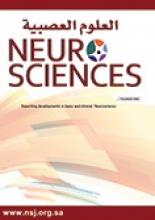Research ArticleOriginal Article
Open Access
Characteristics of neuropathic pain in individuals with chronic spinal cord injury
Hossein Majedi, Mahdi Safdarian, Marzieh Hajiaghababaei, Alexander R. Vaccaro and Vafa Rahimi-Movaghar
Neurosciences Journal October 2018, 23 (4) 292-300; DOI: https://doi.org/10.17712/nsj.2018.4.20180223
Hossein Majedi
From the Department of Anesthesiology (Majedi), School of Medicine, Brain and Spinal Cord Injury Research Center (Majedi, Rahimi-Movaghar), Neuroscience Institute, Sina Trauma and Surgery Research Center (Safdarian, Rahimi-Movaghar), and Psychosomatic Medicine Research Center (Hajiaghababaei), Tehran University of Medical Sciences, Tehran, Iran, and from Rothman Institute (Vaccaro), and from Department of Orthopaedic Surgery (Vaccaro), Thomas Jefferson University, Philadelphia, PA, United States of America
MD, AFSAMahdi Safdarian
From the Department of Anesthesiology (Majedi), School of Medicine, Brain and Spinal Cord Injury Research Center (Majedi, Rahimi-Movaghar), Neuroscience Institute, Sina Trauma and Surgery Research Center (Safdarian, Rahimi-Movaghar), and Psychosomatic Medicine Research Center (Hajiaghababaei), Tehran University of Medical Sciences, Tehran, Iran, and from Rothman Institute (Vaccaro), and from Department of Orthopaedic Surgery (Vaccaro), Thomas Jefferson University, Philadelphia, PA, United States of America
MDMarzieh Hajiaghababaei
From the Department of Anesthesiology (Majedi), School of Medicine, Brain and Spinal Cord Injury Research Center (Majedi, Rahimi-Movaghar), Neuroscience Institute, Sina Trauma and Surgery Research Center (Safdarian, Rahimi-Movaghar), and Psychosomatic Medicine Research Center (Hajiaghababaei), Tehran University of Medical Sciences, Tehran, Iran, and from Rothman Institute (Vaccaro), and from Department of Orthopaedic Surgery (Vaccaro), Thomas Jefferson University, Philadelphia, PA, United States of America
MScAlexander R. Vaccaro
From the Department of Anesthesiology (Majedi), School of Medicine, Brain and Spinal Cord Injury Research Center (Majedi, Rahimi-Movaghar), Neuroscience Institute, Sina Trauma and Surgery Research Center (Safdarian, Rahimi-Movaghar), and Psychosomatic Medicine Research Center (Hajiaghababaei), Tehran University of Medical Sciences, Tehran, Iran, and from Rothman Institute (Vaccaro), and from Department of Orthopaedic Surgery (Vaccaro), Thomas Jefferson University, Philadelphia, PA, United States of America
MD, PhDVafa Rahimi-Movaghar
From the Department of Anesthesiology (Majedi), School of Medicine, Brain and Spinal Cord Injury Research Center (Majedi, Rahimi-Movaghar), Neuroscience Institute, Sina Trauma and Surgery Research Center (Safdarian, Rahimi-Movaghar), and Psychosomatic Medicine Research Center (Hajiaghababaei), Tehran University of Medical Sciences, Tehran, Iran, and from Rothman Institute (Vaccaro), and from Department of Orthopaedic Surgery (Vaccaro), Thomas Jefferson University, Philadelphia, PA, United States of America
MD
References
- ↵
- Cruz-Almeida Y,
- Martinez-Arizala A,
- Widerstrom-Noga EG
- ↵
- Dworkin RH,
- Backonja M,
- Rowbotham MC,
- Allen RR,
- Argoff CR,
- Bennett GJ,
- et al.
- ↵
- Yezierski RP
- ↵
- Bryce TN,
- Biering-Sorensen F,
- Finnerup NB,
- Cardenas DD,
- Defrin R,
- Lundeberg T,
- et al.
- ↵
- Widerstrom-Noga E,
- Biering-Sorensen F,
- Bryce T,
- Cardenas DD,
- Finnerup NB,
- Jensen MP,
- et al.
- ↵
- Biering-Sorensen F,
- Alai S,
- Anderson K,
- Charlifue S,
- Chen Y,
- DeVivo M,
- et al.
- ↵
- Hulsebosch CE
- ↵
- Wrigley PJ,
- Gustin SM,
- McIndoe LN,
- Chakiath RJ,
- Henderson LA,
- Siddall PJ
- Bryce TN,
- Biering-Sorensen F,
- Finnerup NB,
- Cardenas DD,
- Defrin R,
- Ivan E,
- et al.
- ↵
- Treede RD,
- Jensen TS,
- Campbell JN,
- Cruccu G,
- Dostrovsky JO,
- Griffin JW,
- et al.
- ↵
- Fernandes AM,
- De Campos C,
- Batalha L,
- Perdigão A,
- Jacob E
- ↵
- Majedi H,
- Dehghani SS,
- Soleyman-Jahi S,
- Emami Meibodi SA,
- Mireskandari SM,
- Hajiaghababaei M,
- et al.
- ↵
- Henwood P,
- Ellis JA
- ↵
- Li G,
- Lv CA,
- Tian L,
- Jin LJ,
- Sun P,
- Zhao W
- ↵
- Nardone R,
- Höller Y,
- Leis S,
- Höller P,
- Thon N,
- Thomschewski A,
- et al.
- ↵
- Nakipoglu-Yuzer GF,
- Atci N,
- Ozgirgin N
- ↵
- Teixeira MJ,
- Paiva WS,
- Assis MS,
- Fonoff ET,
- Bor-Seng-Shu E,
- Cecon AD
- ↵
- Werhagen L,
- Budh CN,
- Hultling C,
- Molander C
- ↵
- Mann R,
- Schaefer C,
- Sadosky A,
- Bergstrom F,
- Baik R,
- Parsons B,
- et al.
In this issue
Characteristics of neuropathic pain in individuals with chronic spinal cord injury
Hossein Majedi, Mahdi Safdarian, Marzieh Hajiaghababaei, Alexander R. Vaccaro, Vafa Rahimi-Movaghar
Neurosciences Journal Oct 2018, 23 (4) 292-300; DOI: 10.17712/nsj.2018.4.20180223
Jump to section
Related Articles
- No related articles found.
Cited By...
- No citing articles found.





